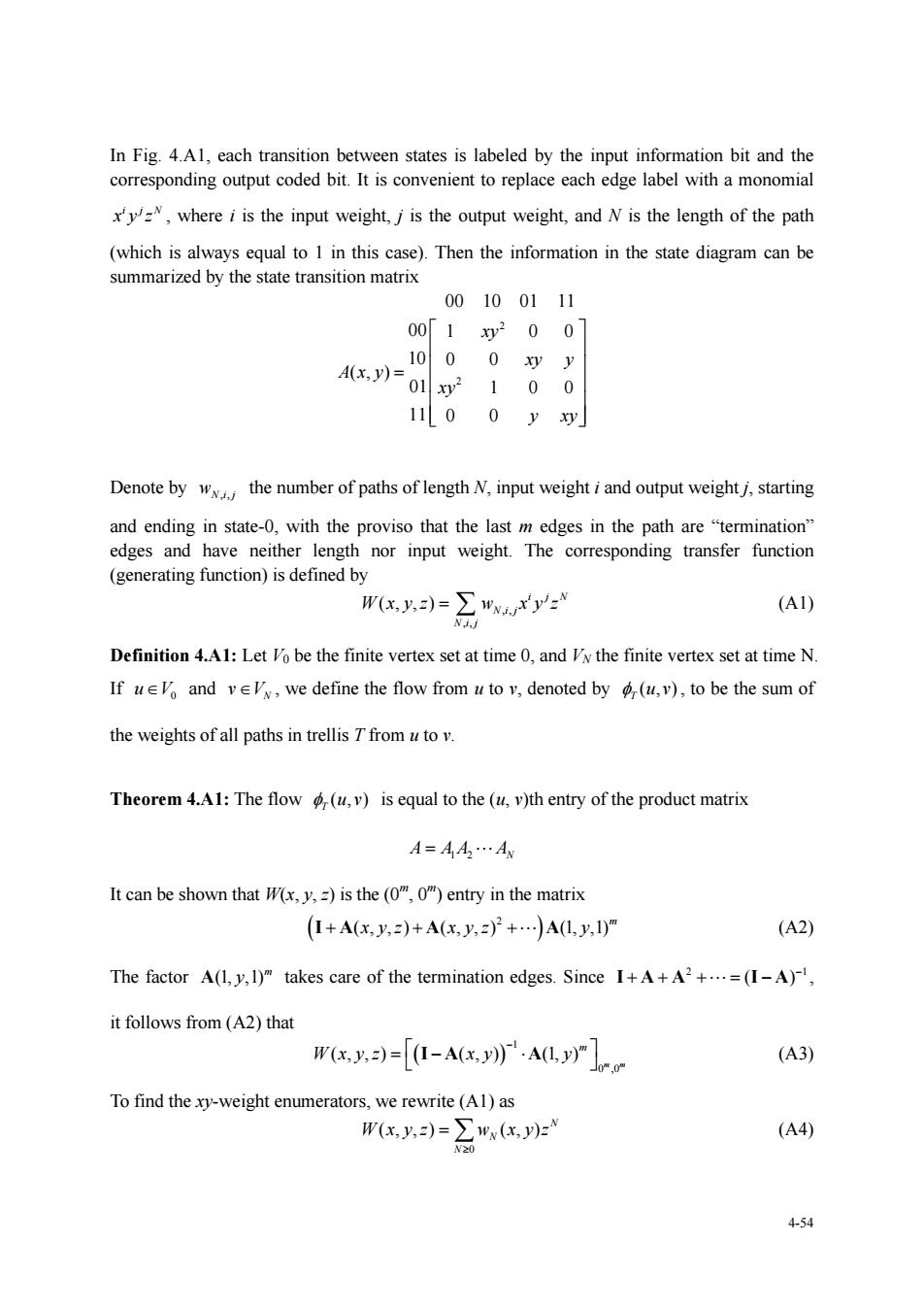正在加载图片...

In Fig.4.Al,each transition between states is labeled by the input information bit and the corresponding output coded bit.It is convenient to replace each edge label with a monomial where i is the input weight is the output weight,and N is the length of the path (which is always equal to I in this case).Then the information in the state diagram can be summarized by the state transition matrix 00100111 00[1y200 1000yy 4x)-01y2100 1100yy Denote bythe number of paths of length N,input weight iand output weightj,starting (generating function)is defined by (A1) Definition 4.A1:Let Vo be the finite vertex set at time 0,and Iy the finite vertex set at time N. If u and vely,we define the flow from u to v,denoted by d(u,v),to be the sum of the weights of all paths in trellis Tfrom uto v. Theorem 4.A1:The flow(u,v)is equal to the (4,v)th entry of the product matrix A=44,.A It can be shown that W(x,=)is the ()entry in the matrix (I+A(xy,z)+A(x,y,z)}2+)AL,y,1) (A2) The factor A(Ly,1)"takes care of the termination edges.Since I+A+A?+=(I-A) it follows from(A2)that W.)=(I-AA( (A3) To find thexweight enumerators,we rewrite(Al)as Wx=∑"(c:4 (A4) 4544-54 In Fig. 4.A1, each transition between states is labeled by the input information bit and the corresponding output coded bit. It is convenient to replace each edge label with a monomial i jN x y z , where i is the input weight, j is the output weight, and N is the length of the path (which is always equal to 1 in this case). Then the information in the state diagram can be summarized by the state transition matrix 00 10 01 11 2 2 00 1 00 10 0 0 (, ) 01 1 00 11 0 0 xy xy y Axy xy y xy Denote by wNi j , , the number of paths of length N, input weight i and output weight j, starting and ending in state-0, with the proviso that the last m edges in the path are “termination” edges and have neither length nor input weight. The corresponding transfer function (generating function) is defined by , , , , (, ,) i jN Ni j Ni j W xyz w xyz (A1) Definition 4.A1: Let V0 be the finite vertex set at time 0, and VN the finite vertex set at time N. If 0 u V and N v V , we define the flow from u to v, denoted by ( , ) T u v , to be the sum of the weights of all paths in trellis T from u to v. Theorem 4.A1: The flow ( , ) T u v is equal to the (u, v)th entry of the product matrix A AA A 1 2 N It can be shown that W(x, y, z) is the (0m, 0m) entry in the matrix 2 ( , , ) ( , , ) (1, ,1)m IA A A xyz xyz y (A2) The factor (1, ,1)m A y takes care of the termination edges. Since 2 1 ( ) IAA IA , it follows from (A2) that 1 0 ,0 ( , , ) ( , ) (1, ) m m m Wxyz xy y IA A (A3) To find the xy-weight enumerators, we rewrite (A1) as 0 (, ,) (, ) N N N Wxyz w xyz (A4)